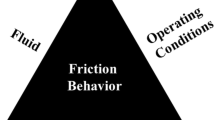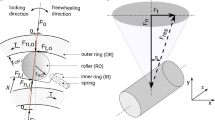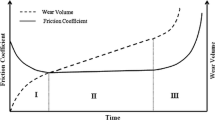Abstract
This paper presents a methodology for re-designing a failed tractor transmission component subjected to cyclic loading. Unlike other vehicles, tractors cope with tough working conditions. Thus, it is necessary to re-design components by using modern optimization techniques. To extend their service life, we present a design methodology for a failed tractor clutch power take-off finger. The finger was completely re-designed using topology and shape optimization approach. Stress-life based fatigue analyses were performed. Shape optimization and response surface methodology were conducted to obtain optimum dimensions of the finger. Two design parameters were selected for the design of experiment method and 15 cases were analyzed. By using design of the experiment method, three responses were obtained: Maximum stresses, mass, and displacement depending on the selected the design parameters. After solving the optimization problem, we achieved a maximum stress and mass reduction of 14% and 6%, respectively. The stiffness was improved up to 31.6% compared to the initial design.
Similar content being viewed by others
References
Y. J. Kim, S. O. Chung and C. H. Choi, Effects of gear selection of an agricultural tractor on transmission and PTO load during rotary tillage, Soil & Tillage Research, 134 (2013) 90–96.
M. Mattetti, G. Molari and A. Vertua, New methodology for accelerating the four-post testing of tractors using wheel hub displacements, Biosystem Engineering, 129 (2015) 307–314.
J. W. Chang and Y. S. Lee, Topology optimization of compressor bracket, JMST, 22 (2008) 1668–1676.
G. K. Nanaware and M. J. Pable, Failures of rear axle shafts of 575 DI tractors, Engineering Failure Analysis, 10 (2003) 719–724.
G. Fourlaris, R. Ellwood and T. B. Jones, The reliability of test results from simple test samples in predicting the fatigue performance of automotive components, Materials and Design, 28 (2007) 1198–1210.
E. S. Palma, C. L. Petracconi and S. E. Ferreira, Fatigue behavior analysis of a rear tow hook pin of a passenger vehicle, Engineering Failure Analysis, 16 (2009) 2408–2416.
H. J. Shim and J. K. Kim, Cause of failure and optimization of a V-belt pulley considering fatigue life uncertainty in automotive applications, Engineering Failure Analysis, 16 (2009) 1955–1963.
R. H. Talemi, A. Zahedi and P. De Baets, Fretting fatigue failure mechanism of automotive shock absorber valve, International J. of Fatigue, 73 (2015) 58–65.
A. Wagner, G. S. Korspeter and P. Hagedorn, Structural optimization of an asymmetric automotive brake disc with cool-ing channels to avoid squeal, J. of Sound and Vibration, 333 (2014) 1888–1898.
D. Xiao, H. Zhang, X. Liu, T. He and Y. Shan, Novel steel wheel design based on multi-objective topology optimization, JMST, 28 (3) (2014) 1007–1016.
Z. Z. Li, Y. D. Shen, H. L. Xu, J. W. Lee, K. S. Heo and S. Y. Seol, Optimal design of high temperature vacuum furnace using response surface method, JMST, 22 (2008) 2213–2217.
K. S. Oh and J. W. Lee, Two-step design process for optimal suction muffler in reciprocating compressor, JMST, 29 (1) (2015) 269–278.
D. Xiao, H. Zhang, X. Liu, T. He and Y. Shan, Novel steel wheel design based on multi-objective topology optimization, JMST, 28 (3) (2014) 1007–1016.
Y. Fu and X. Zhang, An optimization approach for blackandwhite and hinge-removal topology designs, Journal of Mechanical Science and Technology, 28 (2) (2014) 581–593.
P. S. Shenoy and A. Fatemi, Connecting rod optimization for weight and cost reduction, SAE Trans., 114 (5) (2005) 523–530.
N. Kaya, I. Karen and F. Öztürk, Re-design of a failed clutch fork using topology and shape optimization by the response surface method, Materials and Design, 31 (2010) 3008–3014.
S. J. Heo, D. O. Kang, J. H. Lee, I. H. Kim and S. M. H Darwish, Shape optimization of lower control arm considering multi-disciplinary constraint condition by using progress meta-model method, Int. J. of Automotive Tech., 14 (3) (2013) 499–505.
N. Tanlak, F. O. Sonmez and M. Senaltun, Shape optimization of bumper beams under high-velocity impact loads, Engineering Structures, 95 (2015) 49–60.
T. C. Jen and D. J. Nemecek, Thermal analysis of a wetdisk clutch subjected to a constant energy engagement, International J. of Heat and Mass Transfer, 51 (2008) 1757–1769.
A. P. Ompusunggu, J. M. lPapy, S. Vandenplas, P. Sas and H. V. Brussel, A novel monitoring method of wet friction clutches based on the post-lock up torsional vibration signal, Mechanical Systems and Signal Processing, 35 (2013) 345–368.
Y. Liu, D. Qin, H. Jiang, C. Liu and Y. Zhang, Clutch torque formulation and calibration for dry dual clutch transmissions, Mechanism and Machine Theory, 46 (2011) 218–227.
Z. Li-jun, L. Tao and S. Bao-yu, Optimum design of automobile diaphragm spring clutch, IEEE Vehicle Power and Propulsion Conference (VPPC), Harbin, China (2008).
D. Danev, M. Kjosevski and S. Simeonov, Increasing stiffness of diaphragm-spring fingers as a part of system approach improvement of friction clutch function, International J. of Automobile Engineering, 4 (1) (2014) 11–22.
F. Karpat, O. Dogan, C. Yuce, N. Kaya and G. Cengiz, The investigation of stress distribution on the tractor clutch finger mechanism by using finite element method, ASME 2014 International Mechanical Engineering Congress and Exposition, Mechanics of Solids, Structures and Fluids, Montreal, Quebec, Canada, 9 (2014) IMECE2014-39230.
R. Browell and A. Hancq, Calculating and displaying fatigue results, ANSYS Fatigue Module Manual, March 29 (2006).
Author information
Authors and Affiliations
Corresponding author
Additional information
This paper is an extended and enhanced version of the technical paper publication (IMECE2015-52008) presented at ASME International Mechanical Engineering Congress and Exposition, Houston, TX, 13-19 Nov., 2015.
Recommended by Associate Editor Ki-Hoon Shin
Oğuz Doğan received his M.Sc. from Uludag University. He is currently a Ph.D. Student and research asistant at the Uludag University, Mechanical Engineering Department. His interests include machine elements, machine desing, structural optimization tecniques and CAE.
Fatih Karpat received his Ph.D. from Uludag University at 2005. He is now an Associate Professor at the Department of Mechanical Engineering Uludag University. His interests include asymmetric gears, machine elemetns, design, MATLAB programming and finite element method.
Rights and permissions
About this article
Cite this article
Dogan, O., Karpat, F., Yuce, C. et al. A novel design procedure for tractor clutch fingers by using optimization and response surface methods. J Mech Sci Technol 30, 2615–2625 (2016). https://doi.org/10.1007/s12206-016-0522-x
Received:
Revised:
Accepted:
Published:
Issue Date:
DOI: https://doi.org/10.1007/s12206-016-0522-x




